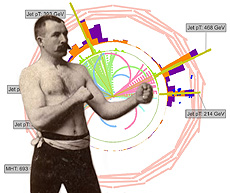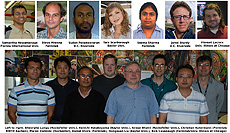Taking them all on at once
 |
| Ready to trounce a continuum of supersymmetric models in one blow. |
Supersymmetry, the notion that matter and forces are two sides of the same coin, is an elegant idea that could explain many of the mysteries of particle physics. Searching for it, however, is not an easy task because there are so many different ways it could manifest itself. As described in last week's Physics in a Nutshell, if supersymmetry exists, it can only be an approximate symmetry. Each model of broken supersymmetry predicts a different pattern of particles, their masses and their decay signatures. In a particle physics experiment, broken supersymmetry could look like just about anything.
How would you search for something that could look like anything? Fortunately, models of broken supersymmetry share a few broad features. For one thing, all of the models predict new particles, the superpartners of the ones we know. These would decay into familiar particles because they maintain part of their identity as they decay— for instance, supersymmetric quarks, called squarks, would decay to quarks. In many models, the lightest supersymmetric particle is invisible, like dark matter, which shows up in a particle collision as an apparent imbalance in the particle debris.
In a recent paper, CMS scientists used these as criteria in a broad search for new physics. They looked for an excess of collision events with many high-energy particles in a lopsided pattern, as though an invisible particle carried away much of the energy. They found nothing new— all was in agreement with known physics.
This result has far-reaching consequences. It rules out many of the simplest models of supersymmetry, but as described in last week's Nutshell, more subtle models lie beyond. It makes some headway into these non-minimal models because so few model-specific assumptions were made in the analysis. It's even general enough to address some non-supersymmetric theories, so the paper's authors present their result in a theory-neutral way.
Sometimes, the lack of an observation can be as exciting as a discovery. While this summer's discovery of a new massive boson was a marvelous achievement, it will confirm a widely held expectation if it turns out to really be the Higgs boson. On the other hand, the simple models of supersymmetry ruled out by this search were also widely expected, and now they are refuted.
—Jim Pivarski
 |
| The U.S. physicists pictured above were all major contributors to this analysis. |
 |
| These are the U.S. members of the CMS Thesis Award Committee, which presents an annual award to one of the best Ph.D. theses in CMS. |
|